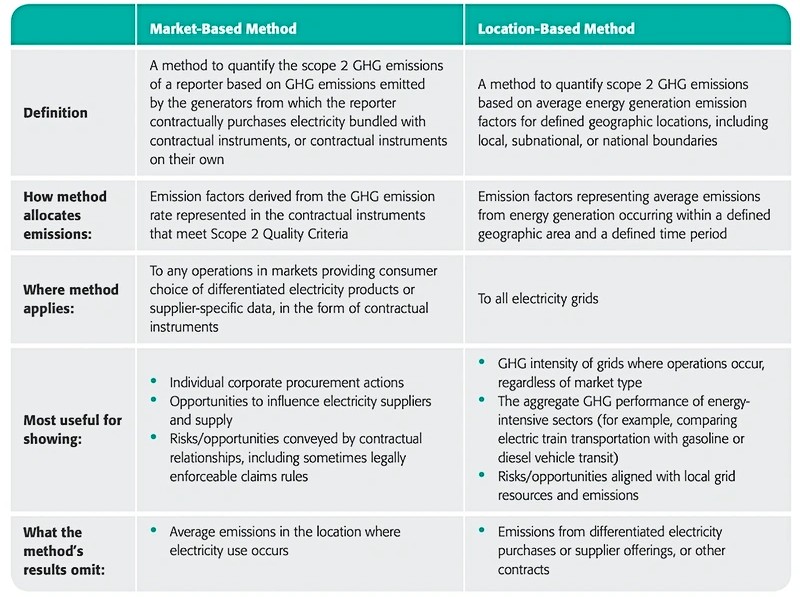
The calculation of emissions, particularly in the realm of energy consumption, is a complex process that requires careful consideration of various factors. Two primary methods, location-based and market-based emissions reporting, play a critical role in understanding your company’s carbon footprint.
This article delves into the intricacies of both methodologies, offering insights into their distinct calculations and implications for businesses.
Both location and market based emissions reporting applies to two emission categories: scope 2 or purchased electricity and scope 3 or fuel and energy related emissions. Let’s break down each method starting with location-based emissions.
Understanding Location-Based Emissions
Location-based emissions refers to what you physically consume at your operations site or business facility. It’s calculated using solely the average emission intensity of the local grid where you source power.

That means a location-based method doesn’t factor in any green measures you’re adopting such as renewable energy credits (RECs). So, location-based emissions would be the same regardless if you use RECs but would be different vs. your market-based emissions.
For a clearer understanding in determining your location-based emissions, let’s use an example of a business in L.A., California. You can find the actual emission factors for your local power grid from the International Energy Agency (IEA) database.
Now, let’s calculate. First step is to get the emissions factor for the average CO2 or GHG intensity of the LA power grid, expressed in kg of CO2e per kWh. Then let’s multiply that emissions factor by the building’s electricity consumption to get Scope 2 emissions.
- Here’s the formula to keep in mind: kWh of electricity used x local grid emissions factor = Location-based Scope 2 Carbon or GHG Emissions
To get location-based emissions for your Scope 3, simply do the same with the upstream emission factor.
The idea behind calculating and reporting Scope 2 location-based emissions is that everyone in the same power grid is equal. Nobody gets exception and everybody shares the same emissions of the grid based on the amount of electricity they consume.
Given the formula above, one option to reduce your location-based emissions is to just decrease overall energy use. Or you can increase on-site renewable energy generation used directly by your office building or production facility.
Understanding Market-Based Emissions
Unlike location-based methods, the calculation for market-based emissions focuses on the individual company and its contract agreements in the market. Market-based emissions are associated with energy a company purchases, which is different from the power the local grid generates.
There are various instruments or contracts involved in getting market-based emissions. These include these common ones:
- Renewable Energy Contracts (RECs)
- Direct contracts
- Supplier-specific emission rates
- The residual mix
Calculating for these energy contracts or instruments should adhere to the GHG protocol Scope 2 emissions quality criteria. If they don’t, the company may still opt to report them separately for transparency. But they can’t be included in calculating market-based Scope 2 emissions.
So how does getting market-based vs. location-based Scope 2 emissions differ?
As mentioned, market-based emissions take into account energy purchase agreements. So, taking the example provided above for location-based emissions, the California company is taking its electricity from the local grid. But they want to buy RECs from a renewable energy developer.
While that company still connects with and consumes power from the grid, the market-based method requires them to factor in emissions of the RECs. By doing that, the company can claim the emission reductions from the renewable energy supply instead of applying the emissions factor of the grid as the case with the location-based method.
Here are the steps to calculate market-based emissions using this formula:
- kWh consumed x Contract source emissions factor (EF) = Market-based Scope 2 CO2e GHG Emissions
- Get the emissions factors for energy sources specified in the contracts (refer to GHG protocol quality criteria)
- Multiple the power bought from a source by its specific emission factor. Do the same for all the sources in energy contracts and sum them all up.
- For electricity use emissions that’s included in your contracts, use the residual mix emission factor.
Residual mix refers to the emission factor for the grid that excludes electricity generation claimed by your electricity contracts.
This approach of measuring emissions is attributed to the same energy consumed used in calculating location-based emissions. When you determine Scope 2 emissions using both methods, you don’t sum them up, but disclose them separately.
The goal is to report these two emissions side-by-side to show different stories about the same activity data.
Comparing Location-Based and Market-Based Emissions
With the differences in calculating Scope 2 emissions, which method should you use?
Given the more detailed and accurate market-based emissions, you might opt for this calculation method. After all, carbon accounting must prioritize accuracy and market-based emissions are more specific to your business operations.
However, calculating market-based is a bit trickier. You need to have a clear understanding of your contract emission factor or know if it’s 100% renewable. It matters a lot as shown in the formula, but it doesn’t fully capture the actual emissions of your energy use.
On the contrary, the location-based method does show it.
According to the World Resources Institute, “the location-based method reveals what the company is physically putting into the air, and the market-based method shows emissions the company is responsible for through its purchasing decisions”.
In other words, both methods tell different sides of the story that’s essential in showing your company’s CO2 footprint. From there, you can decide the corresponding carbon reduction strategies to adopt.
The GHG Protocol provides a comprehensive comparison between the two carbon accounting methods, including their applicability, most useful scenario, and what they miss out.
Market-Based Vs. Location-Based Emissions Method

Policy Implications and Carbon Offsetting
Electricity sourced from a grid lacks differentiation and cannot be distinguished based on its origin. Even if your company buys renewable energy credits (RECs) or similar instruments, they don’t significantly alter or lower your emissions. They also don’t enable a complete disconnection from the grid, unless you establish your own self-sufficient power generation.
You can account for RECs and other carbon credits in your company’s carbon offset inventory. However, they should be accounted for separately as a unique inventory line item and not included in calculating emissions from purchased power.
In contemporary electricity grids worldwide, such as those in the U.S, Canada, and Germany, integrating renewable energy does not result in disconnection from the local electricity grid. Rather, electricity generated by your renewable energy system is often sold back into the grid, with net metering commonly employed.
Consequently, you continue to use grid electricity, with any surplus clean energy benefit shared by all grid users. This integration leads to a reduction in the grid’s overall carbon intensity, a factor that’s useful in accounting for location-based Scope 2 emissions.
Location-Based vs Market-Based Emissions: Closing Thoughts
As new guidance and regulations on carbon accounting and reporting corporate emissions are strengthening, companies should know the basics, at the very least, of factoring in their harmful emissions. Knowing the different methods for accounting emissions, be it location-based or market-based, and their nuances is crucial.
While market-based emissions provide a more granular and specific picture of a company’s carbon footprint, the location-based approach offers transparency about the physical emissions generated at a site.
Recognizing the distinct stories presented by each method allows you to develop effective carbon reduction strategies in line with your company’s or organization’s operational needs and environmental commitments.
Source: carboncredits.com










